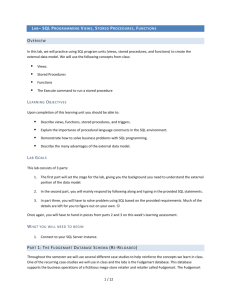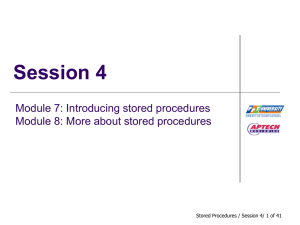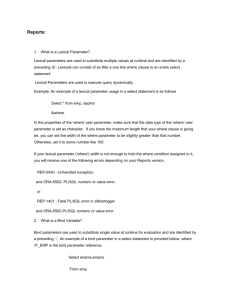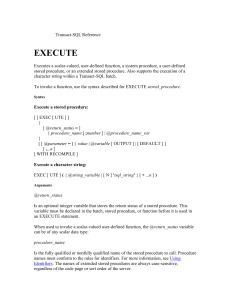Advanced SQL, PL/SQL
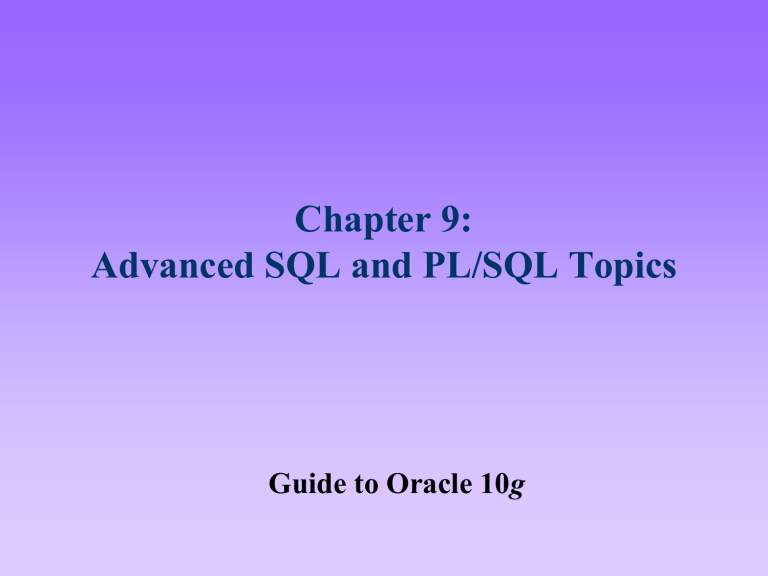
Chapter 9:
Advanced SQL and PL/SQL Topics
Guide to Oracle 10g
Lesson A Objectives
• Grant permissions to users
•
Work with PL/SQL stored program units
• Create server-side stored program units in SQL*Plus
•
Use Forms Builder to create stored program units
2
Granting privileges
• Syntax:
GRANT privilege1, privilege2, …
ON object_name
TO user1, user2, …;
• Example 1:
GRANT SELECT, ALTER
ON student
TO scott;
•
Example 2:
GRANT ALL
ON loc_id_sequence
TO PUBLIC;
3
Revoking privileges
• Syntax:
REVOKE privilege1, privilege2, …
ON object_name
FROM user1, user2, …;
• Example 1:
REVOKE SELECT, ALTER
ON student
FROM scott;
•
Example 2:
REVOKE ALL
ON loc_id_sequence
FROM PUBLIC;
4
Overview of PL/SQL Stored Program Units
•
Program unit
–
Self-contained group of program statements that can be used within larger program
•
Anonymous PL/SQL programs
–
Programs that do not interact with other program units
•
Stored PL/SQL program units
–
Programs that other programs can reference
–
Programs that other DB users can execute
•
Server-side program units
–
Stored as DB objects and execute on the DB server
• Client-side program units
– Stored in the workstation’s file system & execute on the client
5
Types of Oracle 10g Stored Program Units
6
Creating Stored Program Units
• Procedures
–
Receive multiple input parameters
–
Return multiple output values or return no output values
–
Perform action such as inserting, updating, or deleting database records
•
Functions
–
Receive multiple input parameters
–
Always returns single output value
7
Syntax to Create a Stored Program Unit
Procedure
• Parameter mode
–
IN specifies a parameter passed as a read-only value that the receiving program cannot change
–
OUT specifies a parameter passed as a write-only value that can appear only on the left side of an assignment statement in the program unit
–
IN OUT specifies a parameter that is passed and whose value can be changed within the
8 receiving program unit.
Creating a Stored Procedure in
SQL*Plus
9
Calling a Stored Procedure
• Execute directly from SQL*Plus command line
•
Create separate PL/SQL program that contains
–
Command to call stored procedure
–
Passes parameter values to procedure
•
Calling stored procedure from SQL*Plus command line:
EXECUTE procedure_name
( parameter1_value , parameter2_value ,
...);
10
Calling a Stored Procedure (continued)
• Variables passed for each parameter
–
Must be in same order as parameters appear in parameter declarations list
•
Calling stored procedure from separate PL/SQL program
–
Similar to calling stored procedure from SQL*Plus command line
–
Omit EXECUTE command update_enrollment_grade(MA100, 12, B);
11
Creating a Stored Program Unit Function
•
Use CREATE OR REPLACE FUNCTION
12
Creating a Stored Program Unit Function
13
Calling a Function
• Syntax: variable_name := function_name ( parameter1 , parameter2 , ...);
•
Variables passed for parameter values
–
Must be in same order as parameters appear in function declaration
14
Using Forms Builder to Create Stored
Procedures and Functions
• Create and test program unit within form
•
Save as stored program unit in database schema
• Advantage of using Forms Builder
–
Provides enhanced development and debugging environment
–
PL/SQL Editor
15
Creating, Testing, and Saving a Stored
Program Unit Procedure in
Forms Builder
• Create stored procedure in test form
•
Create form trigger to test program unit procedure
• Save program unit as stored procedure in database
•
Database Objects node
–
Contains child nodes that represent every database user
16
Creating, Testing, and Saving a Stored
Program Unit Function in
Forms Builder (continued)
• Create program unit function in Forms Builder
•
Test program unit function
• Save program unit form as stored program unit in database
Show how to use
Ch9ATest_PROCEDURE.fmb and
Ch9ATest_FUNCTION.fmb
17





